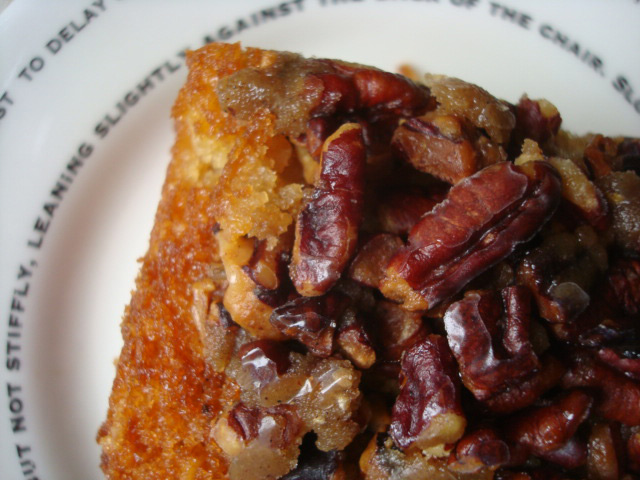 With my first attempt at baking from the new book Seasonal Fruit Desserts
With my first attempt at baking from the new book Seasonal Fruit Desserts by Deborah Madison, I managed to do something rather unlikely: I made a dessert which contained absolutely no fruit, seasonal or otherwise.
What I did, of course, was I flipped right to the back of the book where there is a section entitled "cakes to go with fruit"--and I chose the most rich and delicious-sounding one, the Brown Sugar-Ginger Cream Cake, which was described as having a "poundcake-like personality". Sold! I baked it up, using part almond flour for fun (it made the texture slightly more coarse, I think, but not in such a bad way), and it came out beautifully.
 But how to top it? Flipping to another section of the book, I came across a recipe for Candied Five-Spice Pecans, suggested as a great accompaniment to ripe pears; they sounded good, so I made a batch and put them on top of the cake, completely ignoring that pesky and vaguely healthy-sounding pear part. And oh, are they divine on top of the buttery, rich cake.
But how to top it? Flipping to another section of the book, I came across a recipe for Candied Five-Spice Pecans, suggested as a great accompaniment to ripe pears; they sounded good, so I made a batch and put them on top of the cake, completely ignoring that pesky and vaguely healthy-sounding pear part. And oh, are they divine on top of the buttery, rich cake.
 But ultimately I realized it wouldn't necessarily be honoring the book's, ah, entire mission, to not include fruit, so I sliced up a ripe Washington pear in a skillet with 2 tablespoons of butter and 3 tablespoons of brown sugar, stirring frequently over medium heat until the liquid had reduced and the pear had been battered into sweet, buttery submission.
But ultimately I realized it wouldn't necessarily be honoring the book's, ah, entire mission, to not include fruit, so I sliced up a ripe Washington pear in a skillet with 2 tablespoons of butter and 3 tablespoons of brown sugar, stirring frequently over medium heat until the liquid had reduced and the pear had been battered into sweet, buttery submission.
And you know what? The fruit made it even better, and made me feel a whole lot better about eating it for breakfast (It has fruit! And nuts! It's practically health food!)
Here's how you do it at home.
 Brown Sugar Ginger Cream Cake with Five Spice Pecans and Caramelized Pears
Brown Sugar Ginger Cream Cake with Five Spice Pecans and Caramelized Pears
For the cake
- 1 cup all-purpose flour
- 1/2 cup almond flour (you could use cake or all purpose flour here instead, the original recipe called for 3/4 cup each AP and cake flour, respectively)
- 1 1/2 teaspoons baking powder
- 1/4 teaspoon salt
- 2 eggs, at room temperature
- 1 cup heavy cream
- 1 cup dark brown sugar
- 1 1/2 teaspoons ground ginger
- 1/8 teaspoon freshly ground pepper
- 1 teaspoon vanilla
For the five spice pecans
- 1 cup pecan halves or pieces
- 1 tablespoon butter
- 1 tablespoon sugar
- 1 teaspon five-spice powder
For the caramelized pears
- 1 large ripe pear, sliced thinly
- 2 tablespoons butter
- 2 tablespoons brown sugar
Procedure
- Butter and flour a loaf pan. Line the bottom and ends with parchment paper (it will make your life so much easier). Preheat oven to 350 F.
- Combine the flours, baking powder, and salt in a large bowl; whisk together. Make a well in the middle.
- Using the whisk attachment of an electric mixer, beat the eggs till foamy, then add the cream, sugar, and flavorings. Beat until you have what resembles a soft whipped cream. Pour the mixture into the center of the flour mixture and whisk together just until well combined and lump-free. Scrape batter into the pan and even it out.
- Bake until a cake tester inserted in the center comes out clean, 40-50 minutes (original recipe called for 50-60 minutes, but I think using the almond flour might have altered the baking time).
- Let cool for about half an hour in the pan before loosening the sides with a knife and turning out onto a wire rack to cool.
- Prepare the candied five-spice pecans. Adjust the oven to 300 F. Toast pecans until they are fragrant, about 15-20 minutes. Turn them at about 10 minutes to ensure that they brown evenly.
- Heat your butter in a skillet over medium heat. Add your pecans, and sprinkle the sugar on top. Stir and cook until the sugar melts and covers the nuts. Remove them to a bowl and toss with the five-spice powder. Gently put them on top of the cake (it's ok if the cake is still warm); they will crisp up a bit as they cool.
- Go ahead and use the same skillet and melt some more butter over medium heat; add your slivered pear pieces, and once you've turned the slices once or twice and they're a bit wilty around the edges, add the sugar. Continue to heat until the juices have begun to reduce and the mixture is thick and caramel-y. Serve on top of cake slices.
